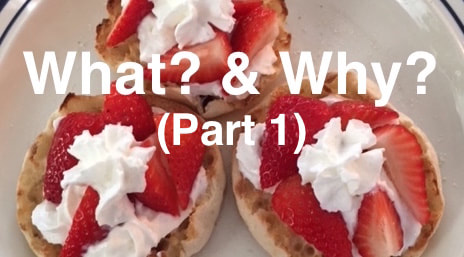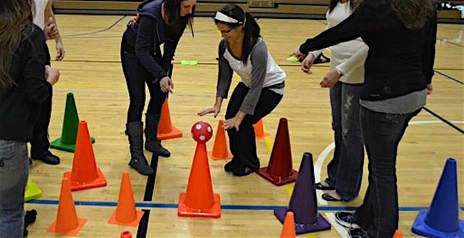I'm guessing most of you know this classic, "Have You Ever...?" ice breaker activity - I'm sure it's been played by millions! Let's review.^ (If you know, Have You Ever..., you can skip past this review.)
Your group, of 12 to 50 players, forms a circle. Each player is standing on a game spot. You are in the middle of the circle explaining the game. You are going to say something true for you - something you have done/experienced. You preface this information with, "Have you ever..." For example, you might say, "Have you ever been to Canada?" (Again, the statement must be true for you.) If anyone in the group (players forming the circle) has been to Canada, he/she is invited to leave his/her spot and move to another spot that is not directly to his/her right or left.
While this movement is happening, you, or any other player in the middle, want to go stand on one of the spots left vacant by one of the players from the circle (the idea is, you don't want to stay in the middle). There will then be a player left without a spot to stand on (because, in this game, there is no sharing spots). The player, without a spot to stand on, is the next person to share a, Have you ever... question from the center of the circle of players. The moving, getting a spot process ensues after every, Have you ever... question from a player standing in the middle of the circle. .
If the player in the middle shares a, Have you ever... question, and no one moves, he/she takes a bow and asks another question. Remembering, the idea is to get players to move - so you want to ask questions that are likely to produce movement.
Back in January of this year, I posted the first What? & Why? Discussion about how I use Name Card Return - an engaging ice breaker for learning names and experiencing a simple problem solving activity to introduce the group to the kinds of activities they will be experiencing. (Thought - Can an icebreaker be a problem solving activity?)
The purpose for this type of discussion for me is to tell you "What" I do with a particular process (e.g., an activity) and then, in "Part 2" (and 3, if I needed), tell you "Why" I do what I did.
I'm using this format, on the one hand, to document my thoughts about some of the things I do during team building programs. On the other hand, I'm thinking, maybe those of you who train team building facilitators could use this format of thinking as a training exercise.
First, you can share the What?, like how you lead a particular activity. Don't reveal the Why? right away. Have a discussion on the What? with the trainees about "Why?" they think the activity is set up the way it is, and "What?" purposeful reasons they might have for leading this activity (or process) in this way. Then, share your Why? behind your What? - what reasons/purpose do you have for leading an activity the way you do. (You can design your own What? & Why? discussions or use one of these FUNdoing blog posts to explore.)
NOTE: Believe it or not, the step-by-step process detailed below takes me about 15 minutes to lead. It's a lot of writing for 15 minutes, and an interesting process (for me) to go through.
Okay, let's get this one started:
- I start by handing out a game spot to everyone in the group while we're all standing together in a clump - I keep one for myself as well.
- Then I ask everyone to form a nice circle and then put his/her game spot on the ground and step on it - I am part of the circle, standing on my game spot.
- I tell the group, "We're going to play a game of choice. I will start out the game. I'm going to ask a question that starts with, Have you ever... and ends with something I've done. For example, Have you ever eaten a slice of pepperoni pizza?"
- I go on to say, "Here's where the choice comes in. If you have eaten a slice of pepperoni pizza in the past, you are invited to move off your spot and go stand on another spot left open by someone else who has eaten a slice of pepperoni pizza. It is your choice whether or not you want to move to a new spot - you can stay right where you are if you want. Again, it's your choice to move or not."
- At this point we want to give it a test run. "Okay, let's try one. Have you ever eaten a slice of pepperoni pizza?"
- After the movement has subsided, I ask the group, "How did it go? What choices did we make during that round?" Here I let the group share the choices that were possible and what choices were made.
- After that sharing, I'll present another Have you ever... question. "Have you ever been a participant in a team building program before this one?" Movement ensues.
- After everyone is back on a spot, I will ask, "Please raise your hand if you moved to a new spot. Now, look around to see who has been team building before, and who has not? Awesome. You can put your hands down."
- At this point I say, "I'll ask you one more Have you ever... question, then I'm going to invite you to ask some questions. Ready? Have you ever climbed a high challenge course element?" Now, at this point, if I am the only one that moves, I simply take a step forward from my spot, take a bow, and step back onto my spot. If others move, we exchange spots.
- If multiple players move, I ask again, "Please raise your hand if you moved to a new spot. Now, look around to see who has something in common with you."
- Now I pass the baton. "Okay, before you all start asking questions, let me give you some important information. If you choose to ask a 'Have you ever...' question, it must be something you've done - something you can answer with, "yes, I've done that." Also, if you ask a question and no one in the group moves from his or her spot, you are invited to step into the circle, take a bow and then step back onto your spot. If you don't want to bow, simply have a hand. If you bow or wave we will all give you resounding applause to celebrate your uniqueness. After the applause, someone else will be invited to ask a question."
- "Alright, who can ask us a Have you ever... question? Remember, it has to be something you've done before." When hands go up I point at a player to share. Sometimes, someone in the group just shouts out a question - you can decide if this okay. Movement ensues.
- When movement stops after each question, I ask the "raise your hand and look around" question so players have time to see who they have something in common with.
- At this point I invite four or five other players to share a Have you ever... question. Movement happens, hands go up, we look around after each question.
- Before the next part of the activity, I come back to asking the group what choices they made during the last several rounds. We will also explore the choices that were NOT made during the last several rounds.
- I then tell the group, "During this first part of the activity, I'm sure you noticed that you all had a spot to go to - even if you moved back to your own spot. Now, we're going to change it up a bit." I then pick up my game spot, move it to the center of the circle, place it down on the ground and step on it.
- At this point some people react to what they believe is going to happen. Here I say, "Okay, now I'm in the center. By being in the center, I am obligated to ask a, Have you ever... question. After I ask a question, I want to get out of the center by moving to, and standing on, an empty spot left behind by someone who moved - don't forget to move to a spot or you will be in the center again. The person left without a spot, after all the circle spots are taken, will stand on the center spot and be the next player to ask a Have you ever... question."
- Before we start this second part, I ask the group, "What do we think will change during this part of the activity? How do we want to play during this part? Remember, you have choices - what are some of these choices?" I provide some time here to talk about the choices ahead - choices to make, and choices not to make.
- After a fruitful conversation about choices we begin. About six to eight questions is usually enough to anchor the experience. Again, when movement stops after each question I ask players to raise their hand if they moved and look around to see who they have something in common with.
- If any "close calls" or safety concerns occur (hopefully no injuries - yes, I've seen it happen), I stop and check in with the group to see how we can proceed in a safer manner. Then, we keep going.
- I then stop the activity, thank the group for playing, and then bring up another conversation about the choices that were made during play, and the choices that were NOT made during the activity.
- After the fruitful conversation, I then tell the group that the program they are taking part in will be filled with choices. Some choices will be easy to make, others will be harder to make. I could ask the players who have participated in team building programs before, "What sorts of choices do you remember making during programs in the past?" I could also provide some examples of choices that might come up during their program, like, "Some of you might have to choose to be a leader in order to help the group move forward during a task." Or, "Some of you might choose to stay quiet and let others share ideas during a planning session." This conversation is about frontloading the idea that each person, and the group, will be faced with choices as they move forward, and the group is there to support these choices.
- I do add one caveat to the choice conversation - this is part of my personal philosophy about choice when it comes to group work. "The one choice I will ask you to make is to stay with the group. It is important for me to know where you are during the program, so by staying together it really helps me out. If you do feel a strong desire to step away from the group, please do so. But, stay close by so I can see where you are. Thank you for helping me out with this choice."
- At the conclusion of this process of choice (again, which usually takes me about 15 minutes), I ask my group, "Are you ready for the next adventure?" We then move into the program at hand.
All the best,
Chris Cavert, Ed.D.
^ Have You Ever...? questions first appeared in Karl Rohnke's Bag of Tricks periodical - he started writing Bag of Tricks in 1978. In 1988 he compiled "...the best writing and most useable copy" from his first 38 issues, into the book, "The Bottomless Bag." Have You Ever...? Questions in this book are introduced as a 'raise your hand if you have' activity - as an ice breaker, the questions were a way to start conversations and share stories. In, The Bottomless Bag, Again (1991), Karl expands, Have You Ever...? by adding a circle of chairs - now, if you 'have' you move from your chair to an open chair. And, the game continues....









 RSS Feed
RSS Feed